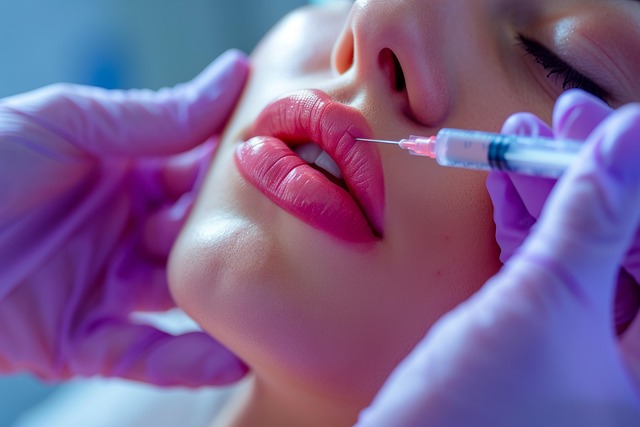Botox, primarily known for its medical benefits in treating chronic migraines, also offers unexpected advantages in slimming the jawline. While it relaxes muscles to alleviate migraine pain, its use for aesthetic purposes carries risks and should be approached with caution. Studies show Botox can prevent headache contractions, providing long-lasting relief for severe migraine sufferers. However, temporary side effects like swelling, bruising, headaches, or muscle weakness may occur, especially when used off-label for jawline slimming. Consulting healthcare professionals is crucial to assess suitability and manage expectations. The future of migraine therapy looks promising with Botox's potential in personalized treatments, alongside its established benefits for jawline slimming.
In the pursuit of effective migraine management, Botulinum Toxin (Botox) has emerged as a promising treatment option. This article delves into the intricacies of Botox’s role in alleviating migraines, exploring its mechanism of action and the benefits it offers. We weigh the risks and side effects, including potential complications, and emphasize safety precautions for patient selection. Additionally, we consider alternative treatments while anticipating future advancements in migraine therapy, with a specific focus on the lesser-discussed benefits of Botox for jawline slimming.
Understanding Migraines and Their Impact

Migraines are a complex neurological condition characterized by recurrent moderate to severe headaches, often accompanied by nausea, sensitivity to light and sound, and in some cases, visual disturbances. These intense episodes can significantly impact an individual’s quality of life, affecting their ability to work, socialize, and engage in daily activities. Migraine symptoms vary from person to person, with some experiencing rare but severe attacks, while others face frequent, debilitating migraines that persist for days.
Understanding the triggers and mechanisms behind migraines is crucial. They are thought to involve abnormal brain activity, leading to the release of certain chemicals that cause inflammation and pain. While there’s no cure, various treatments can help manage symptoms, including medications, lifestyle changes, and alternative therapies. Interestingly, the benefits of Botox for jawline slimming have also been explored in recent years, with some studies suggesting its potential to reduce migraine frequency and intensity by relaxing jaw muscles, which may play a role in migraine development.
Exploring Botox as a Treatment Option

Botox has emerged as a potential treatment option for chronic migraines, offering a non-invasive approach to managing intense and frequent headaches. While its primary use is for medical purposes, there’s growing interest in its off-label application for aesthetic improvements, particularly jawline slimming. This double-edged sword presents both advantages and risks; Botox can reduce muscle tension and pain associated with migraines, but it also carries the potential for adverse effects, especially when used beyond approved indications.
The benefits of Botox for jawline slimming have sparked curiosity among individuals seeking facial aesthetic enhancements. However, it’s crucial to understand that these off-label uses may not be supported by extensive clinical research specifically tailored to these purposes. As with any cosmetic procedure, informed consent and a thorough understanding of potential risks are essential before considering Botox as a treatment option for migraines or jawline contouring.
The Mechanism of Action for Botulinum Toxin

Botulinum toxin, commonly known as Botox, is a protein produced by the bacterium Clostridium botulinum. When administered into specific muscles, it blocks nerve impulses and weakens or paralyzes them. This action leads to muscle relaxation, which has shown promise in various medical treatments. In the context of migraines, Botox injects into targeted head and neck muscles can help reduce the frequency and severity of these debilitating headaches.
Interestingly, one of the recognized benefits of Botox isn’t just limited to its therapeutic effects for migraines but also extends to jawline slimming. As it relaxes muscles in the face and neck, including those responsible for chewing and jaw movement, it can contribute to a more defined jawline appearance—a sought-after effect among many individuals considering cosmetic treatments.
Benefits of Botox for Migraine Management

Botox has emerged as a promising treatment option for chronic migraine sufferers, offering more than just jawline slimming—a common side effect often discussed in the context of its cosmetic uses. The benefits extend to significantly reducing the frequency and intensity of migraines. By relaxing specific muscle groups, Botox can prevent the contractions that trigger headache pain. This non-invasive procedure involves injecting a small amount of botulinum toxin into targeted areas, including the temples, forehead, and neck, which are often associated with migraine onset.
Beyond its ability to slim the jawline, Botox treatment provides long-lasting relief, with results lasting several months. This efficiency in managing migraines is particularly appealing for those who struggle with frequent and severe headaches, as it offers a convenient and effective alternative to oral medications or more invasive procedures.
Risks and Side Effects Associated with Botox Injections

While Botox injections have gained popularity for their benefits in jawline slimming and other cosmetic purposes, they are not without risks. Potential side effects can include temporary swelling, bruising, or discomfort at the injection site. In rare cases, patients may experience headaches, muscle weakness, or difficulty swallowing. These side effects are usually mild and transient, resolving within a few days. However, it’s essential to be aware that Botox is primarily indicated for medical purposes, such as chronic migraine treatment. When used for aesthetic goals beyond its approved indications, the risks can be less predictable.
The safety of Botox injections depends on several factors, including the provider’s expertise, the dosage administered, and individual patient responses. It’s crucial to consult with a qualified healthcare professional who can assess your specific needs and provide guidance tailored to your situation. They will weigh the potential benefits against the risks and help you make an informed decision regarding any cosmetic procedures, ensuring your safety and well-being.
Identifying Potential Complications

Identifying Potential Complications
While Botox offers several advantages, such as the benefits of Botox for jawline slimming and migraine relief, it’s crucial to be aware of possible side effects. Like any medical procedure, Botox injections carry risks that can vary from person to person. Common temporary side effects include mild pain, bruising, or swelling at the injection site. In rare cases, patients may experience more severe complications like headaches, nausea, or difficulty swallowing, especially if the Botox is injected incorrectly.
It’s essential to discuss these risks and benefits openly with your healthcare provider before undergoing any treatment. They can help determine if Botox is suitable for you and guide you on what to expect during and after the procedure. Regular follow-up appointments are also crucial to monitor any potential complications and ensure optimal results.
Safety Precautions and Patient Selection

When considering Botox for migraine treatment, safety precautions are paramount. As with any medical procedure, there are potential risks and side effects associated with Botox injections. Common temporary side effects include mild pain, swelling, or bruising at the injection site. In rare cases, patients may experience headaches, nausea, or muscle weakness. To mitigate these risks, it’s crucial to consult with a qualified healthcare provider who specializes in migraine treatment. They will assess individual patient needs and history to determine suitability for Botox, ensuring the benefits outweigh potential drawbacks.
Ideal candidates for Botox treatment for migraines are those who have tried other preventive medications without significant relief. Patient selection is a critical aspect of successful treatment. The right candidate should have a clear history of migraines, with specific criteria including frequency, severity, and impact on daily life. Additionally, considering the benefits of Botox for jawline slimming can be a factor in patient selection, as some individuals may seek aesthetic improvements alongside migraine relief.
Alternative Treatments and Considerations

While Botox is often associated with facial aesthetic procedures, it has gained attention as a potential treatment for migraines. However, it’s crucial to explore alternative options before considering this approach. Many effective migraine treatments exist, such as medications, biofeedback techniques, and lifestyle changes. For instance, certain drugs specifically target migraine symptoms, offering rapid relief. Additionally, non-invasive procedures like acupuncture or regular exercise routines can significantly reduce frequency and intensity.
When considering Botox, particularly for jawline slimming, it’s essential to weigh the potential risks and benefits. While some studies suggest its efficacy in chronic migraine cases, it may not be suitable for everyone. Botulinum toxin can cause temporary muscle weakness, leading to side effects like difficulty chewing or swallowing. Moreover, its effects fade over time, requiring regular injections for continued relief, which can be costly and invasive. Thus, exploring alternative treatments first is advisable before opting for Botox for migraine management.
Future Prospects in Migraine Therapy

The future of migraine therapy looks promising, with ongoing research and developments that could significantly transform how we manage this debilitating condition. One area gaining traction is the use of Botox for migraines, which has shown potential not only in preventing attacks but also in offering long-lasting relief. The mechanism behind its effectiveness involves reducing nerve activity in the head and neck regions, areas often associated with migraine triggers.
Furthermore, the benefits of Botox extend beyond its current uses. As research progresses, we may uncover additional advantages, especially when it comes to jawline slimming, a side effect that has garnered interest. This procedure could offer a non-invasive approach to managing pain and esthetic concerns simultaneously. With continued exploration, there’s potential for more personalized treatment options, tailored to individual needs, which may revolutionize migraine care in the future.
